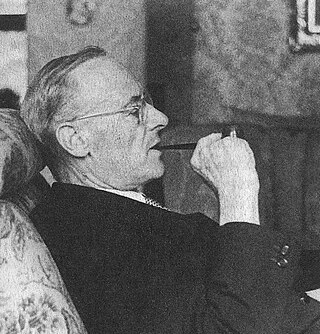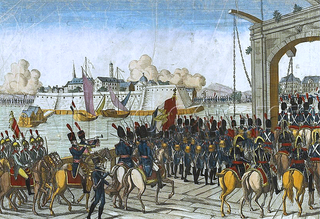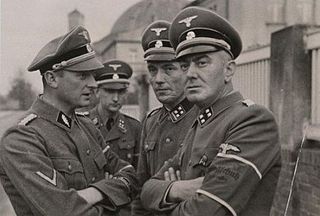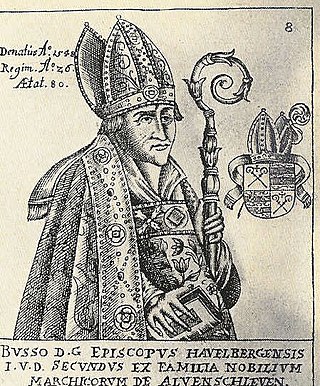
Ludolf-Hermann Emmanuel Georg Kurt Werner von Alvensleben was an SS functionary of Nazi Germany. He held positions of SS and Police Leader in occupied Poland and the Soviet Union, and was indicted for war crimes including the killing of at least 4,247 Poles by units under his command.

Haldensleben is a town in Saxony-Anhalt, Germany. It is the administrative seat of the Börde district.

Reimar Constantin von Alvensleben was a Prussian general.

Ernest of Bavaria was Prince-elector-archbishop of the Archbishopric of Cologne from 1583 to 1612 as successor of the expelled Gebhard Truchsess von Waldburg. He was also bishop of Münster, Hildesheim, Freising and Liège.

Werner von Alvensleben was a German businessman and politician.
The 5th Division was a unit of the Prussian/German Army. It was formed in Crossen in 1816 as a brigade, moved to Frankfurt an der Oder in 1817, and became the 5th Division on September 5, 1818. The headquarters moved to Berlin in 1840 and back to Frankfurt in 1845. The division was subordinated in peacetime to the III Army Corps. The division was disbanded in 1919 during the demobilization of the German Army after World War I. The division was recruited in the Province of Brandenburg.

Neugattersleben is a village and a former municipality in the district Salzlandkreis, in Saxony-Anhalt, Germany. Since 1 January 2010, it is part of the town Nienburg.

Wichard von Alvensleben was a German agriculturist, Wehrmacht Officer, and Knight of the Order of Saint John. He was a member of the aristocratic House of Alvensleben, one of the oldest in Germany.

Gustav von Alvensleben was a Prussian General der Infanterie.

In the Capitulation of Stettin on 29–30 October 1806, Lieutenant General Friedrich Gisbert Wilhelm von Romberg surrendered the garrison and fortress to a much smaller French light cavalry brigade led by General of Brigade Antoine Lasalle. This event was one of a number of surrenders by demoralized Prussian soldiers to equal or inferior French forces after their disastrous defeat at the Battle of Jena-Auerstedt on 14 October. Stettin, now Szczecin, Poland, is a port city on the Oder River near the Baltic Sea, about 120 kilometres (75 mi) northeast of Berlin.

The House of Alvensleben is an ancient, Low German (niederdeutsch) noble family from the Altmark region, whose earliest known member, Wichard de Alvensleve, is first mentioned in 1163 as a ministerialis of the Bishopric of Halberstadt. The family name derives from Alvensleben Castle. They are one of the oldest extant German aristocratic families.

Calvörde Castle is located in Calvörde in the German state of Saxony-Anhalt. Its existence was first recorded in the late 13th century. In the Late Middle Ages and Early Modern Period it was frequently fought over due to its location between the territories of Brandenburg, Magdeburg and Brunswick.

Ernest II of Saxony held two episcopal titles: Archbishop of Magdeburg ; Administrator of the Diocese of Halberstadt.
Colonel Ernst Ludwig Wilhelm von Bismarck was a Prussian officer during the Napoleonic Wars.

Ludolf Jakob von Alvensleben was a German SS-Standartenführer who during the Second World War served as a senior staff member of Operation Reinhard, by which Reichsführer-SS Heinrich Himmler planned to systematically murder the Jews of Europe. Alvensleben ended the war as the SS and Police Leader (SSPF) for Adria-West in Northern Italy/South Tyrol. He avoided prosecution after the war and supposedly died in an automobile accident.

Blüchern is a simple gambling card game for any number of players that is played either with a pack of 52 French playing cards or with a pack of 32 French or German playing cards.
Karl Ludwig Friedrich Wilhelm Gustav von Alvensleben (1800–1868) was a German writer.

Udo August Ernst von Alvensleben was a German art historian.

Hermann Karl Rudolf Gebhard von Alvensleben was a Prussian Generalleutnant who participated in the Austro-Prussian War and the Franco-Prussian War. He commanded the 1st Cavalry Division during the Battle of Königgrätz and commanded several Army Corps' during the Franco-Prussian War.

Busso X von Alvensleben was a Catholic ecclesiastical diplomat and from 1523 to 1548 as Busso II, the last Catholic Bishop of Havelberg.

















